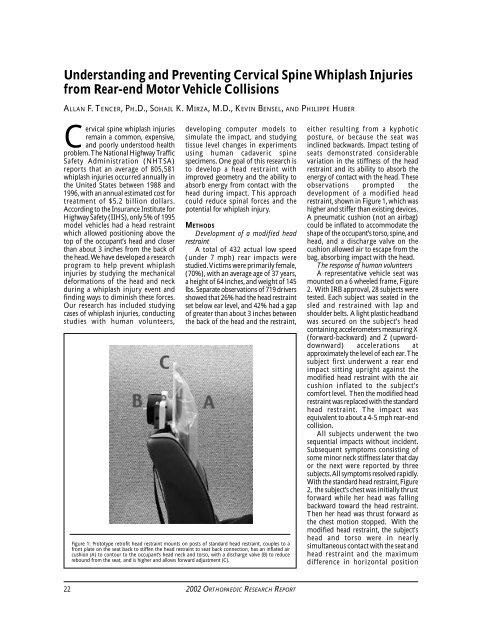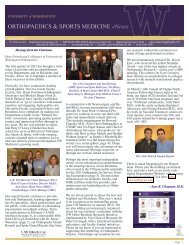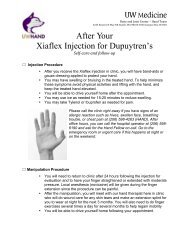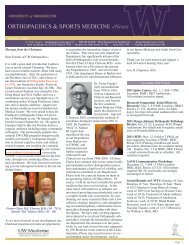2002 - University of Washington Bone and Joint Sources
2002 - University of Washington Bone and Joint Sources
2002 - University of Washington Bone and Joint Sources
You also want an ePaper? Increase the reach of your titles
YUMPU automatically turns print PDFs into web optimized ePapers that Google loves.
Underst<strong>and</strong>ing <strong>and</strong> Preventing Cervical Spine Whiplash Injuries<br />
from Rear-end Motor Vehicle Collisions<br />
ALLAN F. TENCER, PH.D., SOHAIL K. MIRZA, M.D., KEVIN BENSEL, AND PHILIPPE HUBER<br />
Cervical spine whiplash injuries<br />
remain a common, expensive,<br />
<strong>and</strong> poorly understood health<br />
problem. The National Highway Traffic<br />
Safety Administration (NHTSA)<br />
reports that an average <strong>of</strong> 805,581<br />
whiplash injuries occurred annually in<br />
the United States between 1988 <strong>and</strong><br />
1996, with an annual estimated cost for<br />
treatment <strong>of</strong> $5.2 billion dollars.<br />
According to the Insurance Institute for<br />
Highway Safety (IIHS), only 5% <strong>of</strong> 1995<br />
model vehicles had a head restraint<br />
which allowed positioning above the<br />
top <strong>of</strong> the occupant’s head <strong>and</strong> closer<br />
than about 3 inches from the back <strong>of</strong><br />
the head. We have developed a research<br />
program to help prevent whiplash<br />
injuries by studying the mechanical<br />
deformations <strong>of</strong> the head <strong>and</strong> neck<br />
during a whiplash injury event <strong>and</strong><br />
finding ways to diminish these forces.<br />
Our research has included studying<br />
cases <strong>of</strong> whiplash injuries, conducting<br />
studies with human volunteers,<br />
developing computer models to<br />
simulate the impact, <strong>and</strong> studying<br />
tissue level changes in experiments<br />
using human cadaveric spine<br />
specimens. One goal <strong>of</strong> this research is<br />
to develop a head restraint with<br />
improved geometry <strong>and</strong> the ability to<br />
absorb energy from contact with the<br />
head during impact. This approach<br />
could reduce spinal forces <strong>and</strong> the<br />
potential for whiplash injury.<br />
METHODS<br />
Development <strong>of</strong> a modified head<br />
restraint<br />
A total <strong>of</strong> 432 actual low speed<br />
(under 7 mph) rear impacts were<br />
studied. Victims were primarily female,<br />
(70%), with an average age <strong>of</strong> 37 years,<br />
a height <strong>of</strong> 64 inches, <strong>and</strong> weight <strong>of</strong> 145<br />
lbs. Separate observations <strong>of</strong> 719 drivers<br />
showed that 26% had the head restraint<br />
set below ear level, <strong>and</strong> 42% had a gap<br />
<strong>of</strong> greater than about 3 inches between<br />
the back <strong>of</strong> the head <strong>and</strong> the restraint,<br />
Figure 1: Prototype retr<strong>of</strong>it head restraint mounts on posts <strong>of</strong> st<strong>and</strong>ard head restraint, couples to a<br />
front plate on the seat back to stiffen the head restraint to seat back connection, has an inflated air<br />
cushion (A) to contour to the occupant’s head neck <strong>and</strong> torso, with a discharge valve (B) to reduce<br />
rebound from the seat, <strong>and</strong> is higher <strong>and</strong> allows forward adjustment (C).<br />
either resulting from a kyphotic<br />
posture, or because the seat was<br />
inclined backwards. Impact testing <strong>of</strong><br />
seats demonstrated considerable<br />
variation in the stiffness <strong>of</strong> the head<br />
restraint <strong>and</strong> its ability to absorb the<br />
energy <strong>of</strong> contact with the head. These<br />
observations prompted the<br />
development <strong>of</strong> a modified head<br />
restraint, shown in Figure 1, which was<br />
higher <strong>and</strong> stiffer than existing devices.<br />
A pneumatic cushion (not an airbag)<br />
could be inflated to accommodate the<br />
shape <strong>of</strong> the occupant’s torso, spine, <strong>and</strong><br />
head, <strong>and</strong> a discharge valve on the<br />
cushion allowed air to escape from the<br />
bag, absorbing impact with the head.<br />
The response <strong>of</strong> human volunteers<br />
A representative vehicle seat was<br />
mounted on a 6 wheeled frame, Figure<br />
2. With IRB approval, 28 subjects were<br />
tested. Each subject was seated in the<br />
sled <strong>and</strong> restrained with lap <strong>and</strong><br />
shoulder belts. A light plastic headb<strong>and</strong><br />
was secured on the subject’s head<br />
containing accelerometers measuring X<br />
(forward-backward) <strong>and</strong> Z (upwarddownward)<br />
accelerations at<br />
approximately the level <strong>of</strong> each ear. The<br />
subject first underwent a rear end<br />
impact sitting upright against the<br />
modified head restraint with the air<br />
cushion inflated to the subject’s<br />
comfort level. Then the modified head<br />
restraint was replaced with the st<strong>and</strong>ard<br />
head restraint. The impact was<br />
equivalent to about a 4-5 mph rear-end<br />
collision.<br />
All subjects underwent the two<br />
sequential impacts without incident.<br />
Subsequent symptoms consisting <strong>of</strong><br />
some minor neck stiffness later that day<br />
or the next were reported by three<br />
subjects. All symptoms resolved rapidly.<br />
With the st<strong>and</strong>ard head restraint, Figure<br />
2, the subject’s chest was initially thrust<br />
forward while her head was falling<br />
backward toward the head restraint.<br />
Then her head was thrust forward as<br />
the chest motion stopped. With the<br />
modified head restraint, the subject’s<br />
head <strong>and</strong> torso were in nearly<br />
simultaneous contact with the seat <strong>and</strong><br />
head restraint <strong>and</strong> the maximum<br />
difference in horizontal position<br />
22 <strong>2002</strong> ORTHOPAEDIC RESEARCH REPORT















